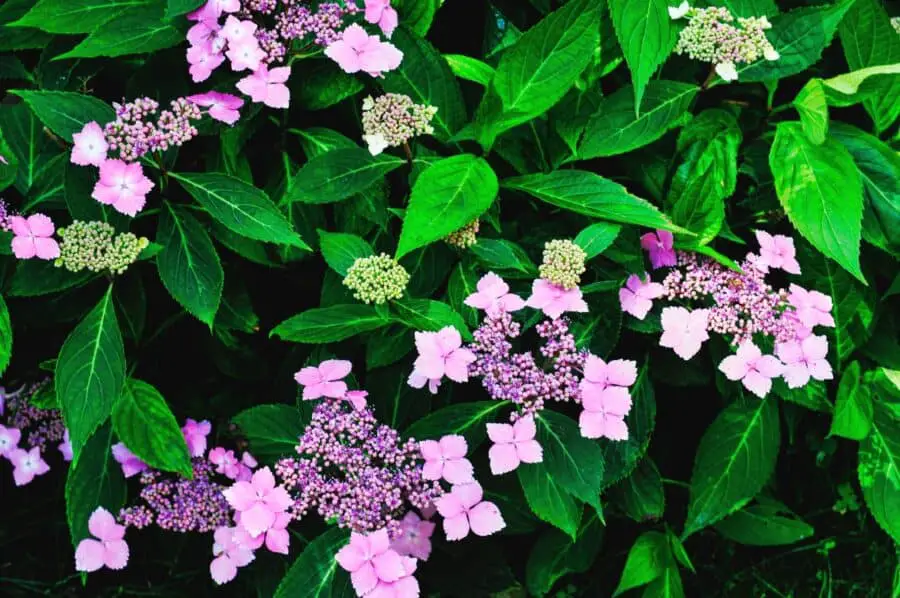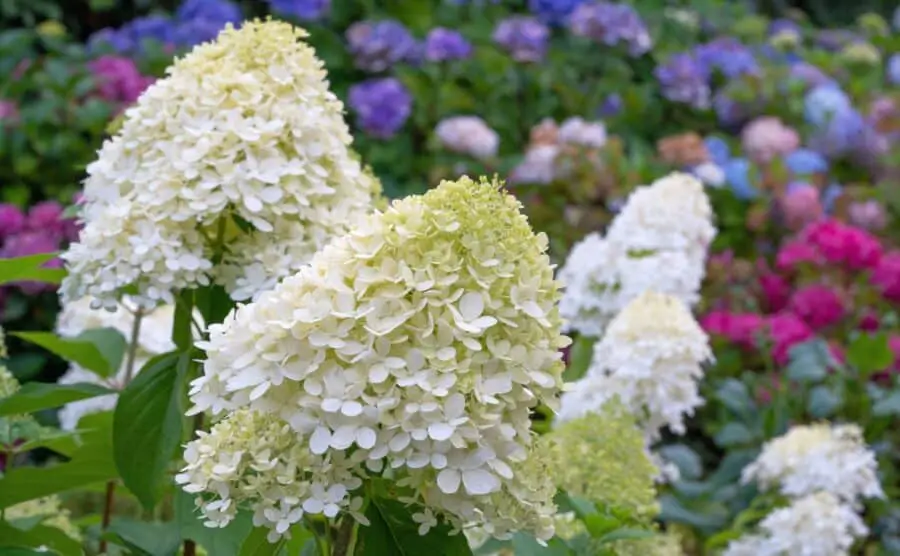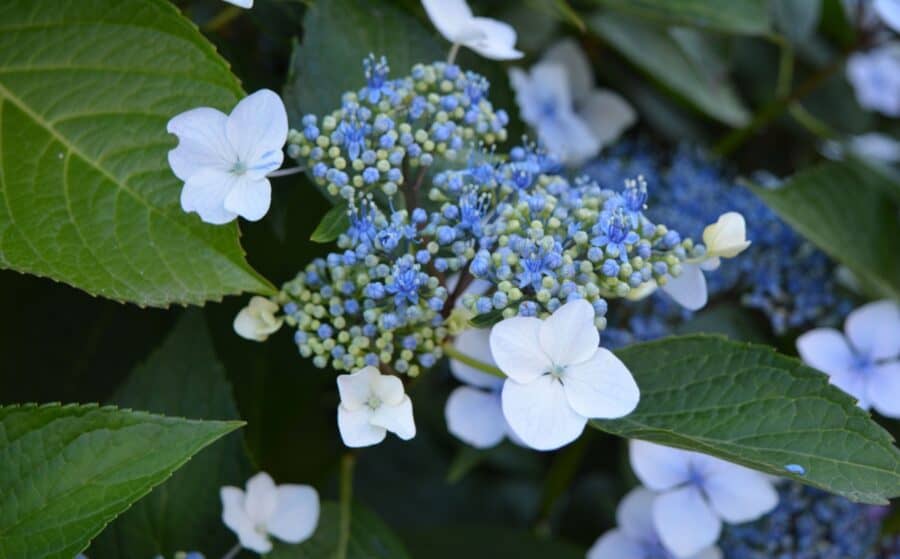Landscaping with hydrangeas and hostas offers a delightful blend of bright flowers and dense foliage. They both favor semi-shade and well-drained soil, which makes them an ideal duo. The colorful hydrangea blooms contrast strikingly against the bold hosta leaves, enhancing any garden’s visual appeal.
Key Takeaways:
Using hydrangeas and hostas can turn shaded areas into visually appealing spaces.
A mix of hydrangeas’ vibrant blooms and hostas’ diverse foliage creates an engaging environment.
Combining these two plants can serve as a serene oasis in your landscape.
Landscaping with Hydrangeas

Discover the art of landscaping with hydrangeas, beautiful blooms that can dramatically enhance your garden’s aesthetic.
Choosing Hydrangea Varieties
When selecting hydrangeas, consider your garden’s location, soil pH, and space. Also consider the spot’s sun exposure.
Finally, think about bloom time and color to ensure a continuous, harmonious display throughout the season.
Choosing the Right Hydrangea for Your Garden
When I started my gardening journey, one thing that baffled me was the sheer variety of available hydrangeas.
Each variety had its unique appeal, and I lost myself in a sea of choices. But as I spent more time with these lovely plants, I learned to appreciate the beauty of this diversity.
Now, let’s delve deeper into this variety so that you can choose the right hydrangea for your garden.
Bigleaf Hydrangeas (Hydrangea macrophylla)

Arguably the most recognized and widely grown of the hydrangea varieties. These charming deciduous shrubs, typically reaching 3 to 6 feet in height, are beloved for their large, round flower clusters ranging from pink to blue, depending on the soil’s pH level.
With two unique types, the ‘Mopheads’ display bold, globular blooms, while ‘Lacecaps’ offer intricate flower clusters with an outer ring of large blooms surrounding a center of small, bud-like flowers.
These hydrangeas favor partial to full shade and moist, well-drained soil.
Bigleaf Hydrangeas are ideal for borders, container gardening, or as an accent plant, adding an exquisite pop of color from late spring to early fall.
Their standout feature is their unique ability to change bloom color, bringing an element of surprise and delight to any garden setting.
Panicle Hydrangeas (Hydrangea paniculata)

They are renowned for their immense, conical flower heads that beautifully ornament the garden from mid-summer to early fall. The flowers start white and gradually mature to a stunning pink-red hue.
Notably hardy, these deciduous shrubs can grow between 8 to 15 feet tall, making a striking statement in your landscape.
Panicle Hydrangeas are more sun-tolerant than most other hydrangea varieties and adapt well to various soil conditions.
Moreover, soil pH does not affect their bloom, which guarantees consistent flower color. Popular varieties include ‘Limelight’ with lush, lime-green flowers and ‘Tardiva’ with tall, airy blooms.
Panicle Hydrangeas offers a versatile solution for any garden, whether as a magnificent stand-alone specimen or incorporated into a border display, from small tree forms to compact shrubs.
Oakleaf Hydrangeas (Hydrangea quercifolia)

Splendid, multifaceted shrubs are native to the southeastern United States.
They are celebrated for their unique, large, oak-shaped leaves. This hydrangea offers a distinct texture to your garden. They typically grow from 6 to 8 feet tall but can reach heights up to 12 feet in optimal conditions.
Large, elongated clusters of white flowers bloom in early to mid-summer, gradually turning shades of pink as they age, and persisting into winter, adding a touch of intrigue during the colder months.
However, the show doesn’t end with flowering; the profoundly lobed, dark green leaves turn a brilliant mahogany-red in autumn, providing spectacular fall color.
Preferring part shade and well-drained soil, these hardy, low-maintenance shrubs are perfect for adding multi-seasonal interest to your garden.
Whether as a specimen plant, in mixed borders, or in woodland gardens, Oakleaf Hydrangeas are an excellent choice for adding drama and texture.
Smooth Hydrangeas (Hydrangea arborescens)

A hardy, North American native shrub appreciated for its ruggedness and breathtaking floral display.
These deciduous plants, typically growing 3 to 5 feet tall and wide, are characterized by their broad, dark green leaves and magnificent snowball-like clusters of white flowers that bloom from early summer through fall.
The ‘Annabelle’ variety is particularly renowned, showcasing large, pure white flower heads that can reach a foot in diameter.
Smooth Hydrangeas are low-maintenance and adapt well to various soil conditions. However, they prefer moist, well-drained soil and partial shade.
With their impressive blooms and resilient nature, these plants can serve as beautiful focal points in your landscape, create dramatic borders, or complement other shade-loving plants in woodland gardens.
Their winter-hardy nature makes them an ideal choice for gardens in colder climates.
Mountain Hydrangeas (Hydrangea serrata)

These are distinctive, compact, deciduous shrubs originating from the mountainous regions of Japan and Korea.
These appealing plants typically reach a manageable size of 2 to 4 feet in both height and spread, making them a perfect choice for garden borders or smaller landscapes.
Mountain Hydrangeas are known for their stunning large clusters of lacecap-like flowers that bloom in a spectrum of colors – the shades of blue or pink are influenced by the soil pH, with acidic soil producing blue flowers and alkaline soil leading to pink ones.
They flower from early to mid-summer, lending a vibrant splash of color to your garden.
Their leaves are another standout feature, characterized by a serrated edge that provides textural interest. In autumn, the foliage turns a stunning reddish-purple, adding a layer of fall interest to your garden.
Whether used as a focal point, a border plant, or as part of a mixed planting, Mountain Hydrangeas offer a charming display of color and form.
| Characteristics of Hydrangea Species | |||||
|---|---|---|---|---|---|
| Hydrangea Variety | Height | Bloom Color & Time | Sun Tolerance | Soil Preference | Key Features |
| Bigleaf Hydrangeas (Hydrangea macrophylla) | 3 to 6 feet | Pink to blue, late spring to early fall | Partial to full shade | Moist, well-drained soi | Changeable bloom color, ideal for borders, container gardening, or as an accent plant |
| Panicle Hydrangeas (Hydrangea paniculata) | 8 to 15 feet | White to pink-red, mid-summer to early fall | More sun-tolerant | Adapts well to various soil conditions | Large conical flowers, consistent color, ideal as stand-alone specimen or in border display |
| Oakleaf Hydrangeas (Hydrangea quercifolia) | 6 to 8 feet, up to 12 feet in optimal conditions | White to pink, early to mid-summer | Part shade | Well-drained soil | Unique oak-shaped leaves, multi-seasonal interest, perfect in mixed borders or woodland gardens |
| Smooth Hydrangeas (Hydrangea arborescens) | 3 to 5 feet | White, early summer through fall | Partial shade | Moist, well-drained soil | Large snowball-like clusters of flowers, low-maintenance, ideal in colder climates |
| Mountain Hydrangeas (Hydrangea serrata) | 2 to 4 feet | Blue or pink, early to mid-summer | Partial shade | Moist, well-drained soil | Compact, unique leaf shape, great for borders or smaller landscapes |
Planting Hydrangeas
To plant hydrangeas, first, choose a location with adequate sunlight. While most hydrangea varieties can tolerate partial shade, some, like panicle hydrangeas, prefer full sun.
Be aware of your chosen variety’s sunlight preferences before planting. Ensure the planting area has well-draining soil, and consider adding compost or organic matter to improve soil structure.
When planting, dig a hole twice as wide and equally deep as the root ball, then backfill it with a mix of native soil and compost.
Caring for Hydrangeas
Hydrangeas require consistent moisture but do not tolerate soggy soil. Water your hydrangeas deeply at the base of the plant to help establish a robust root system.
Applying mulch around the plants can help retain moisture and regulate soil temperature. Use a slow-release fertilizer in early spring for optimal growth, and follow the recommended rates based on your hydrangea variety.
Monitor and adjust your soil pH as needed to maintain the desired flower color when growing Bigleaf Hydrangeas (Hydrangea macrophylla).
Landscaping with Hostas

Hostas are excellent for adding interest and color to your garden, particularly in shaded areas.
These low-maintenance perennials come in various shapes, sizes, and colors, making them a versatile option for any landscape.
This section will cover choosing hosta varieties, planting hostas, and caring for your new additions.
Choosing Hosta Varieties
When selecting hostas for your garden, consider the available sunlight, as some varieties prefer partial shade while others thrive in full shade.
“Landscaping isn’t just about putting plants in the ground – it’s about choosing the right plant for the right place, understanding their needs, and appreciating how they interact with each other and the environment.”
You should create a focal point with larger hostas or use smaller varieties as a ground cover. Additionally, look for hostas with interesting foliage patterns.
Planting Hostas
To get the best results, plant hostas in an area with well-draining soil and consistent moisture, as these plants prefer damp, moist soil.
Pay attention to the soil pH, as hostas thrive in slightly acidic to neutral soil. Try companion planting hostas with other shade-loving perennials, such as daylilies or ferns, for a stunning visual impact.
You can even grow hostas in containers to enhance patios or walkways.
Caring for Hostas
Caring for hostas is relatively simple, as they are known for being low-maintenance plants.
Ensure they receive adequate water, especially during dry spells. While hostas are known for their shade tolerance, be mindful of their specific sunlight requirements, as some may also tolerate more sun.
Keep your garden clean and debris-free to showcase your hostas and minimize potential pest issues.
And with that, you’re well on your way to a beautiful, exciting shade garden featuring these delightful perennials.
Companion Plants for Hydrangeas and Hostas

In the garden symphony, hydrangeas and hostas play the leading roles. But to create a harmonious landscape, we need more players. Let’s explore companion plants that can turn your garden into a vibrant, multi-season spectacle.
Shrubs and Trees
When planning your landscaping with hydrangeas and hostas, consider adding a variety of evergreen shrubs and small trees to complement the lush foliage.
Some ideal options include azaleas and rhododendrons, which provide colorful blooms and blend well with hydrangeas and hostas.
For a more low-maintenance choice, a dogwood tree or gardenia can add beauty and structure to your landscape.
Perennials
A diverse range of perennials will enhance your hydrangea and hosta garden.
Ferns, astilbe, and bleeding hearts grow well in the same conditions as hostas, providing shade and striking contrast with their unique foliage and flowers.
Add spring interest by planting bulbs such as tulips, allium, and muscari.
Consider ajuga (also known as bugleweed), brunnera, or lady’s mantle for ground cover.
Vines
Enhance your landscaping design with climbing plants like vines. A trellis or arbor adorned with clematis or lamprocapnos (formerly known as Dicentra) will create a stunning focal point in your garden.
Perennial vines like these provide seasonal interest and a beautiful backdrop for your hydrangeas and hostas.
If space is limited, try planting begonias along a fence or front yard border for a pop of color throughout the growing season.
Designing with Hydrangeas and Hostas

Dive into the world of designing with hydrangeas and hostas, exploring how these two stunning plants can work together to create an enchanting garden spectacle.
Complementary Features of Hydrangeas and Hostas
Hydrangeas and hostas make a stunning duo in your garden. Their contrasting textures and vibrant colors create visual interest throughout the growing season.
The large, showy blooms of hydrangeas complement hostas’ more subdued, foliage-focused beauty.
Design Considerations for Incorporating Hydrangeas and Hostas Together
When planning your garden, consider the bloom time of your hydrangea paniculata and hosta varieties.
Staggering their bloom times can extend the visual appeal of your garden.
Mixing them with other plants like heuchera, lungwort, and forget-me-not can create a harmonious tapestry of color and texture.
Creating Harmonious Color Palettes and Contrasting Textures
Pick hydrangea and hosta varieties with similar or complementary colors to create a harmonious color palette.
“In the garden, the harmony between hydrangeas and hostas offers a visual feast – an interplay of color, texture, and shape that speaks to the very essence of nature’s artistry.”
For example, you can pair blue hydrangeas with blue or green hostas or pink hydrangeas with purple or gold hostas.
Combining bold, large-leaved hostas with more delicate-looking hydrangeas can also achieve contrasting textures.
Tips for Selecting the Right Locations for Planting Hydrangeas and Hostas
Location is vital when planting hydrangeas and hostas. Both plants prefer partial shade, but hydrangeas need some sun to produce their best blooms.
Consider planting them in a spot with morning sun and afternoon shade.
Hostas, however, can thrive in deeper shade but may also enjoy a little sun. Pay attention to each variety’s specific requirements.
Examples of Successful Landscaping Designs Using Hydrangeas and Hostas
Some successful landscaping designs using hydrangeas and hostas include garden borders, front gardens, and containers.
Hydrangeas make a dramatic statement along a garden border or in a large container on your patio.
You can use hostas to create a lush, textured ground cover under trees or along pathways.
With their wide array of colors and textures, you can design a stunning garden space that adds value and curb appeal to your property.
Frequently Asked Questions

What Are the Best Companion Plants for Hydrangeas
Some great options for companion plants include ferns, coral bells, and astilbes. These plants can create a visually appealing contrast with their delicate textures alongside the bold hydrangea flowers. Select plants that thrive in similar growing conditions to ensure a harmonious landscape.
How Do I Care for Endless Summer Hydrangea
To care for an Endless Summer hydrangea, ensure it receives ample sunlight and adequate water. Morning sun and afternoon shade are ideal for these plants. Prune away any dead or damaged wood and apply a layer of mulch to maintain soil moisture.
What Are Some Tips for Planting Limelight Hydrangea
When planting a Limelight hydrangea, choose a location that provides at least six hours of sunlight daily. Ensure your soil is well-draining and has a pH between 5.5 and 6.5. Leave about three to four feet of space between plants to allow air circulation and prevent overcrowding.
How Can I Incorporate Hydrangea Trees into My Landscape
Hydrangea trees can be used as focal points or along pathways and borders. Plant a hydrangea tree alongside a garden bench or a water feature for a relaxing, serene atmosphere. Consider planting several hydrangea trees together if space permits to create a visually stunning, multi-seasonal border.
What Are the Ideal Conditions for Growing Little Lime Hydrangea
Little Lime hydrangea thrives with well-draining, moist soil in partial to full sun. A pH between 5.5 and 6.5 promotes optimal growth. Look for a location that receives morning sun and afternoon shade to protect the plant from scorching in the summer sun.
Which Foundation Plants Pair Well with Hostas and Hydrangeas
Boxwood, rhododendrons, and euonymus are excellent options for foundation plants. They add structure and contrast to your landscape and can be chosen in different sizes, shapes, and colors to suit your garden design and conditions.

Closing Thoughts
Hydrangeas and hostas are an excellent combination for your landscaping endeavors. They complement each other beautifully, offering visual interest, texture, and a dynamic mix of foliage and blooms.
By choosing the suitable varieties, you can create an inviting and low-maintenance garden that will keep you captivated throughout the seasons.
Incorporate these plants around your property to create focal points, border edges, or shady spots for seating.
Remember, hostas and hydrangeas are relatively easy to care for, making them perfect for gardeners of all experience levels.
Ensure proper soil and moisture conditions to promote healthy growth and stunning displays year after year.
“As a gardener, your role is to create a dialogue between the earth and its inhabitants – a dialogue that transcends language, communicates through beauty, and enriches our everyday lives.”
Feel free to get creative and experiment with various hydrangea and hosta pairings.
After all, it’s your garden, and the result should bring you joy and satisfaction.
With proper planning, time, and care, your hydrangea and hosta landscaping will become your neighborhood’s envy.